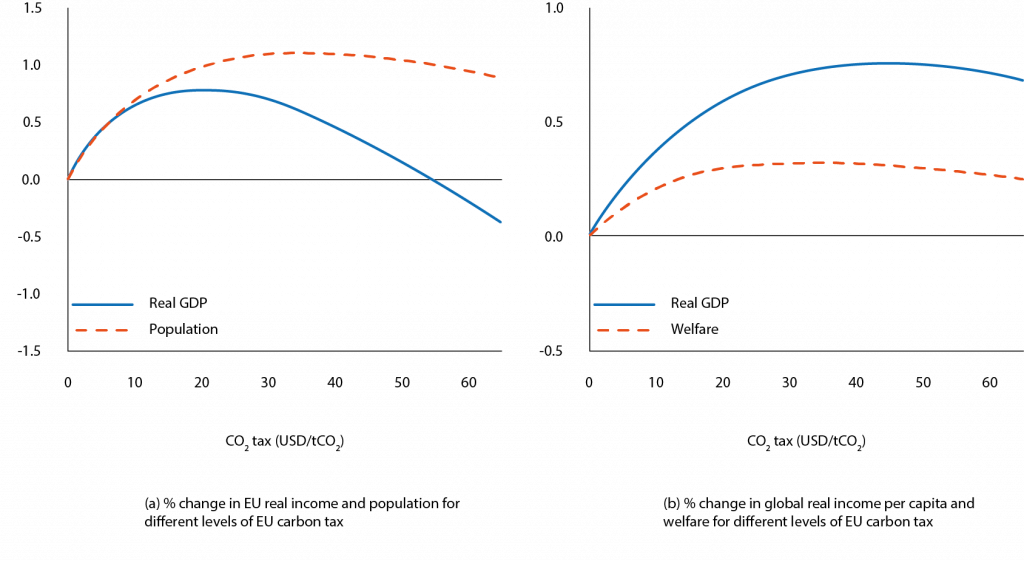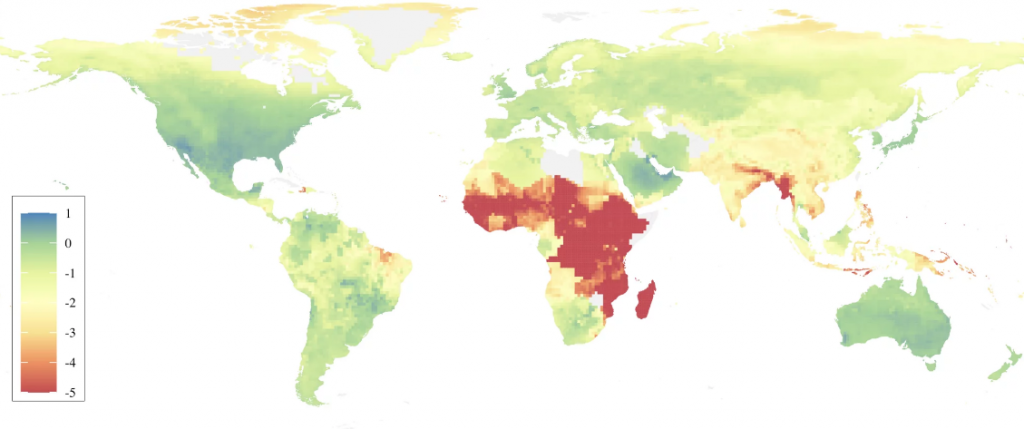Carbon taxes may be a boon for the world, even in the short run
Bruno Conte is a Research Fellow at CESifo and Assistant Professor at the University of Bologna, Klaus Desmet is a Research Fellow at the CEPR and a Professor at the Southern Methodist University, and Esteban Rossi-Hansberg is the Glen A Lloyd Distinguished Service Professor at the Kenneth C Griffin Department of Economics at the University of Chicago
Carbon taxes are often viewed as an intergenerational transfer, with today’s generation paying the cost of saving tomorrow’s climate. This reasoning ignores how a carbon tax interacts with the complex forces that shape the economic geography of the world.
Using a dynamic spatial integrated assessment model, this column shows that a carbon tax of $40 per tonne of CO2 introduced by either the EU or the US would on impact expand the local economy and generate global welfare gains. It is time to take another serious look at carbon taxes; they are less costly than you thought.
Carbon emissions constitute a global externality that requires a policy solution; so much is clear to most policymakers. The exact form such a solution might take is less clear though. In theory, this global externality could be solved by using a global Pigouvian tax that bridges the gap between the social cost and the private cost of carbon emissions (Golosov et al 2014).
In practice, a global agreement has been elusive, partly because the costs and benefits of carbon pricing differ significantly across countries (Desmet and Rossi-Hansberg 2015, Cruz and Rossi-Hansberg 2022) and partly because countries have strong incentives to defect and free ride. In the absence of a global agreement, countries can of course still opt to tax carbon unilaterally.
However, this option is often viewed as ineffective due to the potential economic and carbon leakage (Ishikawa and Haitao 2021). Countries that impose a unilateral tax fear that economic activity will move to locations where firms can emit freely, thereby hurting the countries introducing the tax and undoing the environmental benefits.
In a recent paper (Conte et al 2022), we argue that this logic is incomplete and inaccurate, because it fails to account for the complex interaction of a carbon tax with the forces that shape the economic geography of the world.
Using a two-sector dynamic spatial integrated assessment model (S-IAM), we show that a carbon tax of $40 per tonne of CO2 in either the EU or the US would on impact expand the local economy and generate global welfare gains. These positive effects materialise as soon as the tax is introduced, and so before considering further gains that accrue over time due to lower emissions and a slowdown in global warming.
A unilateral carbon tax expands the local economy on impact
How can a distortive carbon tax have these positive effects on impact? Consider a simple example where a single location, say a municipality, introduces a carbon tax. This pushes up the marginal cost of local producers. While this negatively impacts the demand for their goods, both locally and in other markets, the drop in local revenues is limited if the tax is not too large and the trade elasticity is not too high.
Once the municipality rebates the tax income to the local population, we show that income per capita in the municipality may actually grow as a result of the tax.
The argument is reminiscent of an optimal tariff argument by which the location pushes up the relative price of its exports due to the tax, and ends up gaining because the tax incidence falls mostly on customers outside its own municipality, while the tax revenue is redistributed only to its own residents.
Of course, the tax also generates a distortion, but if the tax is not too large and the tax incidence is mostly passed on to non-residents, local income increases. This attracts new residents to the municipality, causing an expansion of the local economy.
Embedding this mechanism in a world with many locations (more than 17,000 in our quantification), we assess the overall impact of either an EU or a US carbon tax. When a large region like the EU imposes a carbon tax, the core mechanism described above affects all locations within the EU, but more those where the tax incidence is greater.
Taxing carbon tends to be a hard sell, because it is viewed as an intergenerational transfer, with the current generation bearing a loss. Our assessment shows that there need not be such a short-run loss
Because agriculture is less energy intensive than the rest of the economy, the incidence of a carbon tax will in general be larger in regions that specialise more in non-agriculture. Following the effects described above, this reallocates income and economic activity towards non-agricultural industrial areas.
If these areas are particularly productive, the tax will act as a well-designed placed-based policy: it will incentivise concentration of economic activity in the most productive areas of the region that imposes the tax.
For a European carbon tax, we find increased concentration of economic activity in the EU’s geographic core. For a US carbon tax, economic activity also concentrates in areas specialised in non-agriculture, such as the Northeast, the urban part of the Midwest, and the West Coast.
The relative improvement of the region implementing the tax implies that it attracts migrants from the rest of the world, particularly from poorer areas that specialise in agriculture (Figure 1a).
In the examples where the EU and the US introduce a locally rebated carbon tax, sub-Saharan Africa and parts of Southeast Asia lose population (Figure 2). As such, the region that implements the tax does not suffer from economic leakage; on the contrary, its economy expands.
Figure 1. Effect of EU carbon tax

Global welfare gains
Because the original equilibrium is not efficient due to pervasive congestion and agglomeration forces, these migration flows have the potential to improve world welfare. In our quantification, they lead to global welfare gains at impact of roughly 0.3% (Figure 1b). Though not particularly large, these short-run gains are significant in light of the sometimes negative perception of such a tax.
Indeed, taxing carbon tends to be a hard sell, because it is viewed as an intergenerational transfer, with the current generation bearing a loss. Our assessment shows that there need not be such a short-run loss.
Figure 2. Percentage change in population due to EU carbon tax

Because the tax incidence depends on the local energy intensity of production, the rebate will vary by a location’s industry composition. Ultimately, this is what makes carbon taxes act as a place-based policy that promotes the concentration of economic activity in certain locations.
Because in Europe and the US the locations that specialise in more energy-intensive activities are also more productive, the place-based policy aspect of the carbon tax shifts economic activity to the most productive regions.
In spite of the expansion of the local economy, emissions decline precipitously because of the carbon tax: by around 40% for the $40 carbon tax we consider.
While local rebating is probably the most natural way to redistribute the tax revenues, clearly other forms of rebating might weaken this mechanism.
For example, if we redistribute the revenue uniformly across all agents in the region imposing the tax, the place-based component of the policy is weaker, and the ensuing gains smaller.
More drastically, if we redistribute the tax revenues outside the taxing region, say, to the developing world, the effects reverse. In that case, we would of course help the developing world, but we would also keep people there from moving to Europe or the US, ultimately leading to a drop in average global efficiency and welfare.
In this sense, the form of rebating should be a crucial element in the design of a carbon tax.
Our argument is quite general: any policy that differentially affects locations in a large area will change the spatial distribution of economic activity and have aggregate implications. Carbon taxes are such a policy.
More importantly, in the specific case of carbon taxes, their effect on the spatial redistribution of economic activity is such that it yields global welfare gains. Since the local economy does not decline, there is no need for additional policies such as carbon border adjustments designed to prevent economic and carbon leakage.
Time to take another look at unilateral carbon taxes. They are less costly than you thought.
References
Conte, B, K Desmet and E Rossi-Hansberg (2022), “On the Geographic Implications of Carbon Taxes”, NBER Working Paper 30678.
Cruz, J L and E Rossi-Hansberg (2022), “Local Carbon Policy”, NBER Working Paper 30027.
Desmet, K and E Rossi-Hansberg (2015), “On the Spatial Economic Impact of Global Warming”, Journal of Urban Economics 88(C): 16–37.
Golosov, M, J Hassler, P Krusell and A Tsyvinski (2014), “Optimal Taxes on Fossil Fuel in General Equilibrium”, Econometrica 82(1): 41–88.
Ishikawa, J and C Haitao (2021), “Carbon tax, cross-border carbon leakage, and border tax adjustments”, VoxEU.org, 16 September.
This article was originally published on VoxEU.org.




